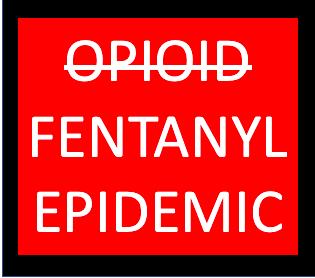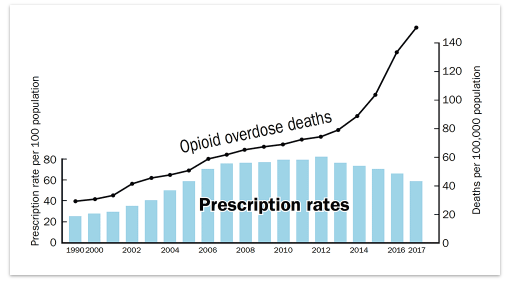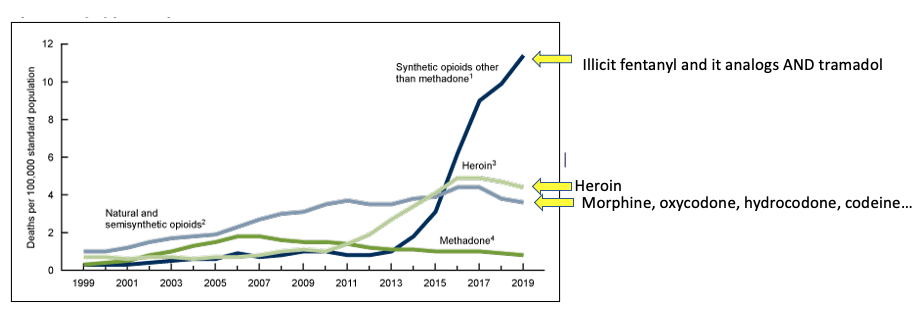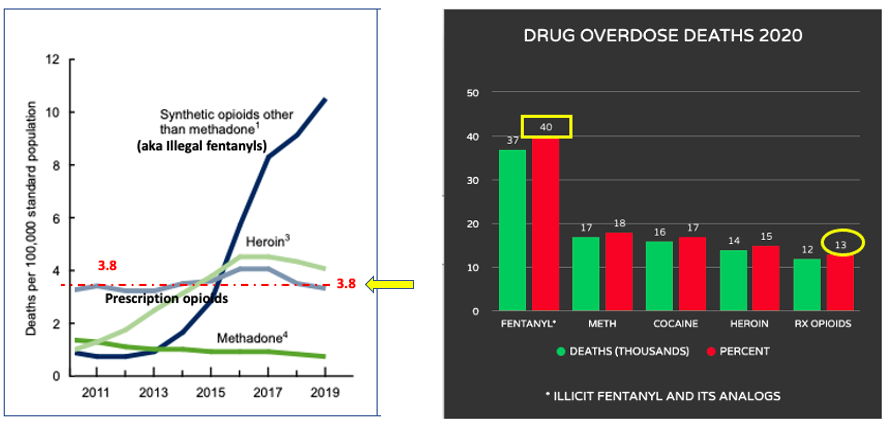
It's time to update our language, something that is routinely done to ensure accuracy and minimize antiquated, bigoted, and offensive terms. Think about some of the changes we've seen in the past few decades. You don't need me to tell you that terms for people of different races, ethnicities, genders, and sexual orientations have changed. And it's not just that. There are no longer stewardesses, only flight attendants. Go into CVS and ask where the rubbers are. Note the look that the pharmacist will give you. Try referring to someone with a learning disability as "retarded" or an unmarried woman as a "spinster." See how well that is received.
Likewise, it is time to stop calling the overdose deaths of 100,000 people an opioid crisis. The term is outdated and inaccurate. And, in my opinion, it is being intentionally misused by various groups and individuals (you know who they are) to push their own agendas and perhaps to benefit financially. What's the harm in using an inaccurate name? Plenty. More on that later.
Those of us intimately familiar with this topic can gauge the damage that the continued use of this term has done, especially to the hundreds of millions of pain patients in this country and drug abusers. The pain patients suffer needlessly while the abusers die from overdoses of fentanyl (the illegal stuff and its analogs). The impact of incorrect wording is immense because, as the name implies, we are fighting the wrong war.
The term itself "opioid epidemic" conjures up false images of surgical patients becoming addicted and perhaps dying because they were given a couple of days of post-operative morphine or – god forbid – a week's worth of oxycodone pills after discharge. Many pain patient advocates, including ACSH advisors Richard (Red) Lawhern, and Jeffrey Singer, M.D., have been arguing for years that the plausible narrative that prescription pain medications are the root cause of drug overdoses is dead wrong, something that is conclusively pointed out by Volkow and McLellan in their review in the New England Journal of Medicine.
The False Narrative is REALLY false
“To be more accurate, it’s really a prohibition crisis. Drug prohibition and the profits it generates fuels the development and distribution of ever more dangerous drugs to sell to non-medical users. The supply of diverted prescription pain pills dried up years ago. The cartels filled the void first with heroin, and next with fentanyl, which is used even more these days because the pandemic is disrupting heroin supply chains. A focus on prescription pain pills is completely out of touch with today’s reality."
Jeffrey Singer, M.D. Cato Institute, ACSH advisor
This false narrative is parroted ad nauseam by a lazy and compliant media, so much so that most people – even medical professionals – still wrongly believe that the so-called "opioid epidemic" is a direct result of a lax prescription practice. This is demonstrably false, as Dr. Singer has indicated. This can also be seen in Figure 1.

Figure 1. Since 2012 opioid overdoses have been inversely related to rates of prescription of legal pain medications. It does not take a vivid imagination to foresee what will happen if prescription rates are decreased further. Source: Skeptic, CDC.
Words Matter
Much of our flawed drug policy – such as it is – begins and ends with the word "opioid." The term as used is so broad that it makes no distinction between legal or illegal drugs, weak or strong, and deadly or safe. Instead, they are all lumped together under the "opioid banner" such that it is impossible for most people (and lawmakers) to know which drugs are responsible for what.
For example, tramadol (weak and legal), morphine (strong and legal), heroin (strong and illegal), and fentanyl (very strong and mostly (1) illegal) are all designated "opioids," even though they have little in common except binding to some opioid receptors. This is a confusing and unscientific way to classify drugs. If you're hoping for clarity from the CDC, look elsewhere. In fact, the agency proves my point [emphasis added]:
"The age-adjusted rate of drug overdose deaths involving synthetic opioids other than methadone, which include drugs such as fentanyl, fentanyl analogs, and tramadol, increased from 1.0 per 100,000 in 2013 to 11.4 in 2019.
Do these drugs belong together? No, not even close. This is a bit like saying that "deaths from auto accidents and being hit over the head with a salami increased by 40% over the last decade." While most of us would determine that the cars, not the salamis, were responsible for the increase in deaths, there is no way to conclude anything of the sort about tramadol and fentanyl from the CDC's own data. The two drugs are tossed into the same category for no reason except that neither comes from a natural source, so they are "synthetic" – a thoroughly useless and confounding term (2).
Want more proof? If you can't tell how ridiculous it is to group tramadol with fentanyl, consider the following (3):

Do these drugs belong in the same category? References - (a) Toxicology Letters (b) Resource Outreach
Yet, this doesn't stop the CDC from regularly putting out nonsense like Figure 2, where all opioids, no matter their properties, are combined in ways that make no sense, something I have written about before. Bad science? Intentional obfuscation? Both?

Figure 2. "Synthetic opioids" refers to illegal fentanyls and tramadol. Prescription analgesics, such as oxycodone and hydrocodone, are called "natural and semisynthetic opioids." Heroin is called heroin, but it technically belongs in the latter category since it is a semisynthetic derivative of morphine. You could throw darts and do better than this. Source: CDC: Drug Overdose Deaths in the United States, 1999–2019
Bad Science Makes Bad Policy
As a result of bad science, we get awful policies, such as cutting back prescriptions to minimize overdose deaths, when the opposite has clearly been the case. Although in recent years, the news media has (finally) caught on to the fact that something really bad called fentanyl is out there, fentanyl deaths are conflated with those from medically used painkillers. I believe this is a major reason that the term "opioid epidemic" has persisted. But even a cursory look at Figure 3 shows why the term is no longer appropriate.

Figure 3. (Left) Since 2011, the number of overdose deaths involving fentanyl has gone ballistic. During this same timeframe, deaths involving prescription pills remained unchanged. (Right) Overdose deaths of different classes of drugs 2019-20. In 2020 prescription opioids were involved in 13% of OD deaths while fentanyl deaths were triple that. Source (Left) CDC National Center for Health Statistics, (Right) DrugAbuse.gov, CDC: Vital Systems Rapid Release: Overdose Death Counts
"Since 2016, restrictions on opioid prescribing begun with CDC guidelines have reduced medical prescriptions by 50%. But overdose-related deaths -- primarily from illegal fentanyl mixed with other substances, sometimes in fake prescription pills -- have doubled. Is this supposed to be "success?"
Richard (Red) Lawhern, Ph.D. Patient advocate and ACSH advisor
The term "opioid epidemic" should be retired.
Figure 3 (Right) shows that in 2019 and 2020, prescription opioids ranked fifth in overdose deaths, yet this category is the only one where the term "opioid" is used. We are not having an epidemic of prescription opioid drugs. Perhaps this was accurate a decade ago, but now it is illegal street drugs, primarily fentanyl, killing people. It is both simple and more accurate to call the overdose epidemic in the US a "fentanyl overdose epidemic." Using this term would help remove the undeserved stigma associated with pain pills, immensely benefiting the more than 100 million adult pain patients in the US.
It's time for a change.
Notes:
(1) There are really "two fentanyls." One is pharmaceutical fentanyl used for pain and general anesthesia. This is NOT what is killing people. The killer is illicit fentanyl and its analogs pouring into the US from Mexico and China. If you add in the analogs that have been seized in the US, that number jumps to 30.
(2) The source of any chemical, synthetic or naturally occurring, is irrelevant. No instrument or living organism can tell the difference between a chemical from the lab or the same chemical from a tree. They are in every way identical.
(3) It is difficult to determine the lethal dose of tramadol in humans because on its own it is rarely fatal. Tramadol becomes more dangerous when taken with other drugs as it has numerous drug-drug interactions. Tramadol used with other drugs can be a fatal combination.



